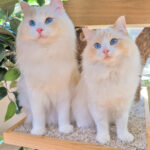Hyenas, with their powerful builds and dog-like appearance, often mislead casual observers into thinking they are canines. However, despite sharing some superficial similarities with dogs, the reality is quite different. Scientific research and evolutionary biology place hyenas firmly on the feline side of the carnivore family tree, making them more closely related to cats than to dogs. This might come as a surprise, but delving into their classification and genetic makeup reveals fascinating insights into these misunderstood creatures.
Hyenas: More Feline Than Canine in Their Lineage
The key to understanding the hyena-cat-dog relationship lies in the scientific classification of carnivores. Carnivora, the order that includes all meat-eating mammals, is further divided into two suborders: Feliformia and Caniformia. Feliformia, often referred to as the cat-like carnivores, includes families like Felidae (cats), Viverridae (civets and genets), Herpestidae (mongooses), and Hyaenidae (hyenas). Caniformia, or dog-like carnivores, encompasses families such as Canidae (dogs, wolves, foxes), Ursidae (bears), and Mustelidae (weasels, otters).
Hyenas belong to their own unique family, Hyaenidae, but crucially, this family is nested within the Feliformia suborder. This placement is not based on mere looks, but on a wealth of anatomical, behavioral, and genetic evidence. While hyenas might exhibit some dog-like traits in terms of social behavior and hunting strategies, their fundamental biology aligns them more closely with the feline lineage. Dogs, on the other hand, are classified under Caniformia, placing them on a separate evolutionary branch.
Scientific Evidence: Genetics and Placental Traits
The classification of hyenas within Feliformia is strongly supported by genetic studies. These studies analyze DNA to trace evolutionary relationships, and they consistently show that hyenas share a more recent common ancestor with cats and other feliforms than they do with dogs and other caniforms. In fact, genetic analysis reveals that hyenas are even more closely related to mongooses and civets than they are to true cats, but the overarching point remains: their evolutionary roots are firmly planted in the feline suborder.
Further evidence comes from unique placental characteristics. While both hyenas, dogs, and cats are mammals and share some general placental features common to carnivores, hyenas exhibit specific placental traits that are more akin to those found in other feliforms, distinguishing them from caniforms like dogs. These subtle but significant biological markers reinforce the scientific consensus on hyena classification.
Expert Consensus: Hyenas are “Cat-Branch” Carnivores
Experts in fields like ecology, zoology, and evolutionary biology overwhelmingly agree on the feline affinity of hyenas. As Dr. Christine Drea from Duke University explains, hyenas “group with the ‘cat branch’ (Feloidea) of the order Carnivora, not with the ‘dog branch’ (Canoidea).” This expert opinion, echoed by numerous other scientists, underscores the well-established scientific understanding of hyena classification.
Similarly, Dr. Ned Place from Cornell University succinctly states, “The simple answer is that hyenas are more closely related to cats than dogs.” He points out the suborder distinction – Feliformia for hyenas and cats, and Caniformia for dogs – as a clear indicator of their divergent evolutionary paths.
Conclusion: Embracing the Feline Side of Hyenas
In conclusion, while their outward appearance might suggest a canine connection, hyenas are definitively more closely related to cats. Taxonomy, genetic studies, placental characteristics, and expert consensus all converge on this point. The next time you see a hyena, remember that beneath the dog-like exterior lies a fascinating carnivore with a surprisingly feline family tree. They are a testament to convergent evolution, where similar ecological pressures can lead to superficial resemblances between distantly related animals, but their true evolutionary story is one that firmly places them in the “cat-like” world of Feliformia.

